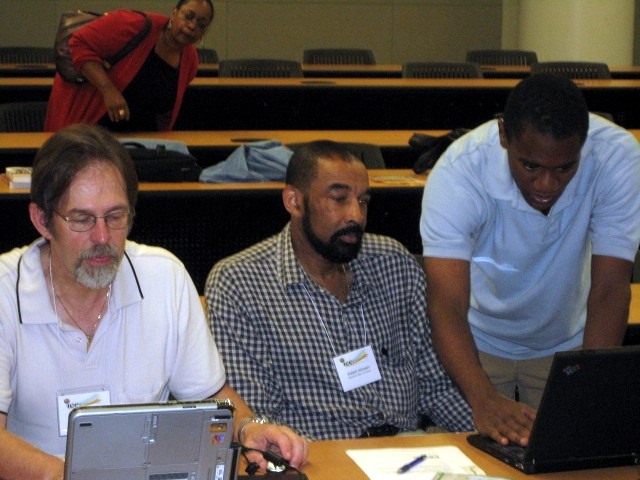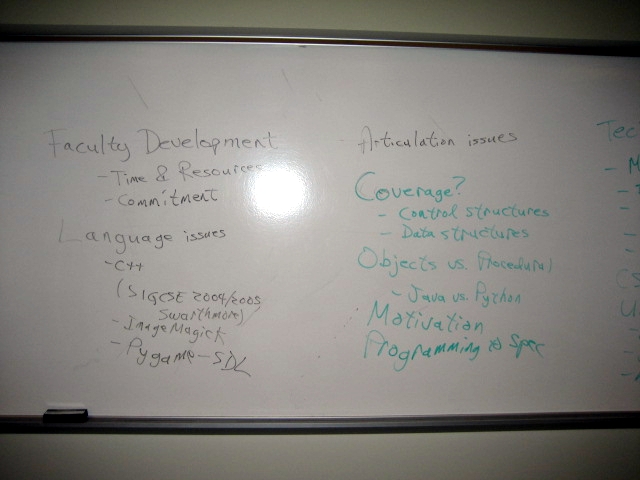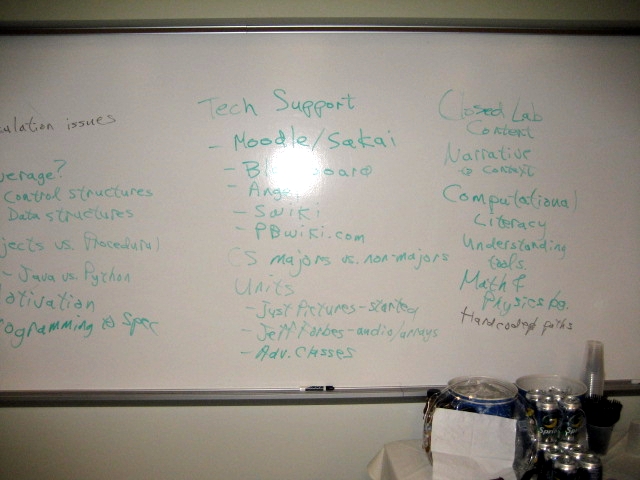







Images and Discussion from 11-13 June 2007 Workshop
Some of the participants as we were getting set-up.

Whiteboards from the discussion "What are the issues in adopting Media Computation (whole courses or just pieces)?"


Here's my expansion of these points:
- Faculty development is an issue: Time to learn a new approach, resources, and commitment on the part of the faculty and the department.
- Language issues: Some schools have to use C++. See the Swarthmore SIGCSE paper on their C-based image library). There are also C++ bindings to ImageMagick and SDL Library for cross-platfrom multimedia.
- Articulation issues. Can we cover enough to match up to the next class which may not change to match?
- Overall, there were reports that some teachers adopting media computation found that their students didn't have as strong an understanding of control structures. (See Guzdial's response at http://www.amazon.com/gp/blog/post/PLNK1IJCOXS1TUIWM)
- In the Java vs. Python discussion, there's also an object-oriented vs. procedural tension that sets off some religious fervor.
- Is motivation really the most critical factor for CS education?
- The creative assignments are great for engaging students, but it's not teaching students to program to specification. The specification evolves as the students create. On the one hand, that buys them more time-on-task as they explore and learn about programming. On the other hand, they're missing out on what a software engineer does. Is that a critical factor?
- If you do use a Wiki or something similar in your class, can you get technical support for it? Moodle, Sakai, Blackboard, and Angel all have Wiki-like capabilities. Swiki is freely available. http://pbwiki.com will host Wikis for you for free.
- This approach seems pretty clearly a win for non-majors. How about CS majors?
- There were few arguments that much of this material could fit easily as a unit within existing courses, even for CS majors. For example, the pictures sections makes for a nice unit at any level (e.g., can use it in an advanced way even to do vision examples, or as a simple intro). Jeff Forbes at Duke uses the sound classes for learning arrays.
- There needs to be more content to support closed labs.
- The content is good for supporting a sense of context and a narrative about the class.
- The content is particularly good for supporting computational literacy, and helping even non-majors to understand their tools.
- Do the students (and faculty) have the appropriate math and physics background to do media computation?
- There are too many hard-coded paths in the code. That may help student understanding, but it makes it harder to use in new settings and for the faculty to set it up to work the first time.
Link to this Page